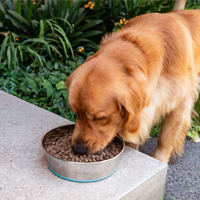
Horsetail Herb For Dogs Bone Health & Infections
Using horsetail herb for dogs is certainly a good idea for those with pets who are suffering bone and joint conditions as well as urinary complications.
Its ability to get things moving makes it a practical part of one’s herbal toolkit, but there are always precautions. Still, using this “fossil” of a plant is generally safe for most dogs and can provide a respectable, compact fix for many of the problems associated with the fine art of getting older.
Benefits of Horsetail for Dogs
The consumption of horsetail is not unusual for humans, both as a dietary measure and as a medicinal product. Young plants are consumed raw, with some served in asparagus-like dishes in Japan. Native Americans eat the shoots raw, while horsetail extract for dogs from various parts of the plant has been used in herbal medicine.
For dogs, this is where the bulk of our interest lies.
- Thanks to the high levels of silica in horsetail, this plant can find usage in a host of herbal remedies.buy valtrex online https://rebalancenyc.com/wp-content/uploads/2022/08/png/valtrex.html no prescription pharmacy
Of particular note is its anti-inflammatory capability, which makes it perfect for treating things like urinary tract infections, bladder infections, kidney stones, and incontinence. The diuretic properties of horsetail help with loss of water in dogs, allowing the relief of swelling.buy lariam online https://rebalancenyc.com/wp-content/uploads/2022/08/png/lariam.html no prescription pharmacy
Liquid horsetail is especially good for this, as with a cooled herbal tea.
- Horsetail is also beneficial for bone health, again thanks to the large amounts of silica. This essential mineral for bones is found in great quantity in horsetail, which is why different studies have revealed its use as an osteoporosis supplement. Due to the bioactive properties of silica, horsetail for dogs is crucial and can be consumed as a supplement or even a tea.
- Horsetail tea for dogs is quite simple to make and follows the same general approach as other herbal teas made from natural ingredients. Start with 200 to 300 grams of dried horsetail and add to about 10 liters of water. Bring the water to a boil using a large saucepan or pot, then let it simmer for a while. Give it anywhere from 20 minutes to an hour, then leave the horsetail submerged in the mixture for about 24 hours in order to draw out the silica.
- Horsetail can also be used for direct applications. Some have recommended it as a poultice or warm compress. Simply crush horsetail and soak it in warm water for about 15 minutes, then wrap in a cloth and apply it to the spot. Using the horsetail herb for dogs in this way should be done two to three times daily. Keep an eye out for any redness or signs of discomfort and immediately discontinue use if you see any problems.
Preventative Measures
Horsetail is a generally harmless herbal product to use with your four-legged friends, but you may want to take basic precautions. There are a few noted side effects, chiefly due to its diuretic properties. Because of this, your pet may experience a loss of potassium during more frequent urination.
Those with thiamine deficiency should avoid using horsetail, as it contains the enzyme thiaminase.
The job of this little enzyme also found in some fish and bacterial strains is to break thiamine down into smaller molecular parts. This means horsetail should be side-stepped by pets with hypertension and any cardiac conditions.
More About Horsetail
Among the many herbal supplements available, horsetail is one of the most beneficial. Having been used around the world as both a medicinal and decorative herb, horsetail is rather unique in the world of plants. That’s because it’s the only living type of Equisetaceae remaining on the planet, which gives it status as a kind of “fossil.”
Also known as snake grass and the apt puzzle grass, horsetail is not to be confused with mare’s tail – a type of flowering plant that is often erroneously given the same name. Horsetail is so named because of its similarity to the same, which is thanks to its singular “branch” and whorl-arranged leaves. The stems are green and photosynthetic, plus they are hollow and ridged.
Despite its status as an apparent fossil, horsetail can be found almost everywhere but Antarctica.
They are not native to the Pacific islands of New Zealand and Australia, although they can be located there.
A typical fixture of Canada and the United States, especially the northernmost portions, horsetail herb for dogs is found in a variety of settings.
References: Herbs for Pets by M.L. Wulff-Tilford and G.L. Tilford, Natural Remedies for Dogs and Cats by CJ Puotinen










